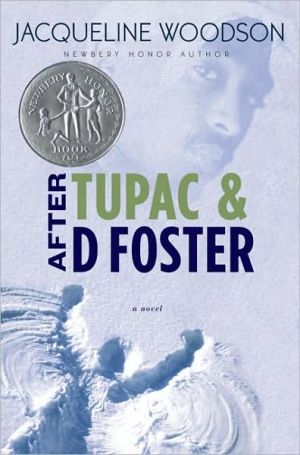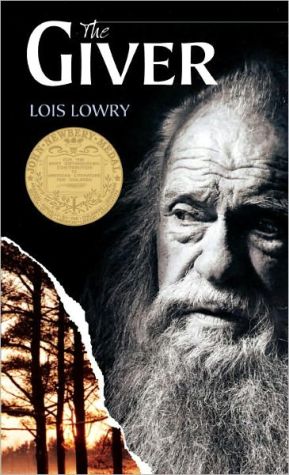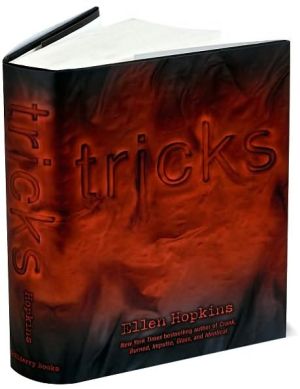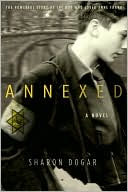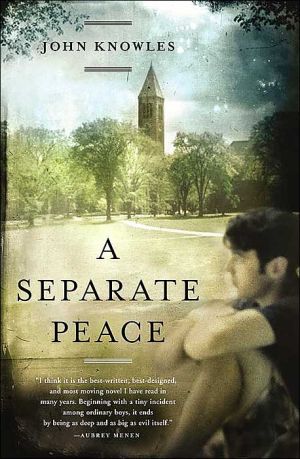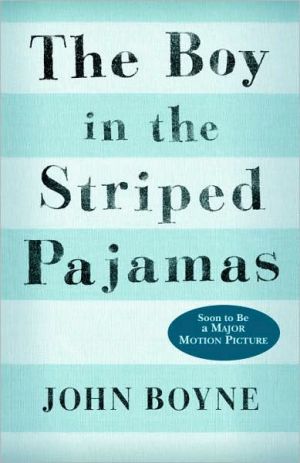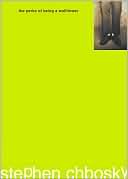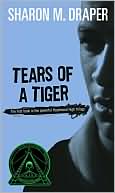After Tupac and D Foster
The day D Foster enters Neeka and her best friend’s lives, the world opens up for them. Suddenly they’re keenly aware of things beyond their block in Queens, things that are happening in the world—like the shooting of Tupac Shakur—and in search of their Big Purpose in life. When—all too soon—D’s mom swoops in to reclaim her, and Tupac dies, they are left with a sense of how quickly things can change and how even all-too-brief connections can touch deeply.\ A Discussion Guide to After Tupac...
Search in google:
D Foster showed up a few months before Tupac got shot that first time and left us the summer before he died. The day D Foster enters Neeka and her best friend's lives, the world opens up for them. D comes from a world vastly different from their safe Queens neighborhood, and through her, the girls see another side of life that includes loss, foster families and an amount of freedom that makes the girls envious. Although all of them are crazy about Tupac Shakur's rap music, D is the one who truly understands the place where he's coming from, and through knowing D, Tupac's lyrics become more personal for all of them. The girls are thirteen when D's mom swoops in to reclaim D—and as magically as she appeared, she now disappears from their lives. Tupac is gone, too, after another shooting; this time fatal. As the narrator looks back, she sees lives suspended in time, and realizes that even all-too-brief connections can touch deeply.The Washington Post - Elizabeth Ward…[a] slender, note-perfect novel.
The summer before D Foster’s real mama came and took her away, Tupac wasn’t dead yet. He’d been shot five times—two in the head, two down by his leg and thing and one shot that went in his hand and came out the other side and went through a vein or something. All the doctors were saying he should have died and were bringing other doctors up to his room to show everybody what a medical miracle he was. That’s what they called him. A Medical Miracle. Like he wasn’t even a real person. Like he was just something to be looked at and turned this way and that way and poked at. Like he wasn’t Tupac.\ D Foster showed up a few months before Tupac got shot that first time and left us the summer before he died. By the time her mama came and got her and she took one last walk on out of our lives, I felt like we’d grown up and grown old and lived a hundred lives in those few years that we knew her. But we hadn’t really. We’d just gone from being eleven to being thirteen. Three girls. Three the Hard Way. In the end, it was just me and Neeka again.\ The first time Tupac got shot, it was November 1994. Cold as anything everywhere in the city and me, Neeka, D and everybody else was shivering our behinds through the winter with nobody thinking Pac was gonna make it. Then, right after he had some surgery, he checked himself out of the hospital even though the doctors was trying to tell him he wasn’t well enough to be doing that. That’s when everybody around here started talking about what a true gangsta he was. At least that’s what all the kids were thinking. The churchgoing people just kept saying he had God with him. Some of the parents were saying what they’d always been saying about him—that he was heading right to what he got because he was a bad example for kids, especially black kids like us. Crazy stuff about Tupac being a disgrace to the race and blah, blah, blah. The wannabe gangsta kids just kept saying Tupac was gonna get revenge on whoever did that to him.\ But when I saw Tupac like that—coming out of the hospital, all skinny and small-looking in that wheelchair, big guards around him—I remember thinking, He ain’t gonna try to get revenge on nobody and he ain’t trying to be a disgrace to anybody either. Just trying to keep on. Even though he wasn’t smiling, I knew he was just happy and confused about still being alive.\ Went on like that all winter long, then February came and they sent Tupac to jail for some dumb stuff and people started talking about that—the negative peeps talking about that’s where he needed to be and all the rest of us saying how messed up the law was when you didn’t look and act like people thought you should.\ Spring came and Pac dropped his album from prison and this one song on it was real tight, so we all just listened to it and talked about how bad-ass Pac was—that he wasn’t even gonna let being in jail stop him from making his music. Me and Neeka and D had all turned twelve by then, but we still believed stuff—like that we’d grow up and marry beautiful rapper guys who’d buy us huge houses out in the country. We talked about how they’d be all crazy over us and if some other girl walked by who was fine or something, they wouldn’t even turn their heads to look because they’d be so in love with us and all. Stupid stuff like that.\ In jail, Pac started getting clear about thug life, saying it wasn’t the right thing. He got all righteous about it and whatnot, and with all the rappers shooting on each other and stuff, it wasn’t hard to agree with him.\ Time kept passing on that way. Things and people changing. First, D turned thirteen, then me and Neeka were right there behind her—us all turning into teenagers, getting body, getting tall, boys acting stupid over us.\ Seems soon as we started settling into all that changing, D’s mama came—took her away from us.\ And time kept on creeping.\ Then Tupac went and died and it got me thinking about D. About the short time she was with us and about how you could know somebody real good but not know them at the same time. And it made me want to remember. Yeah, I guess that’s it. I guess that’s what I’m trying to do now. . . .
\ Elizabeth Ward…[a] slender, note-perfect novel.\ —The Washington Post\ \ \ \ \ Publishers WeeklyAs she did in Featherswith the poetry of Emily Dickinson, Woodson here invokes the music of the late rapper Tupac Shakur, whose songs address the inequalities confronting many African-Americans. In 1994, the anonymous narrator is 11, and Tupac has been shot. Everyone in her safe Queens neighborhood is listening to his music and talking about him, even though the world he sings about seems remote to her. Meanwhile D, a foster child, meets the narrator and her best friend, Neeka, while roaming around the city by herself ("She's like from another planet. The Planet of the Free," Neeka later remarks). They become close, calling themselves Three the Hard Way, and Tupac's music becomes a soundtrack for the two years they spend together. Early on, when Tupac sings, "Brenda's Got a Baby," about a girl putting her baby in a trash can, D explains, "He sings about the things that I'm living," and Neeka and the narrator become aware of all the "stuff we ain't gonna know [about D]," who never does tell them where she lives or who her mother is. The story ends in 1996 with Tupac's untimely death and the reappearance of D's mother, who takes D with her, out of roaming range. Woodson delicately unfolds issues about race and less obvious forms of oppression as the narrator becomes aware of them; occasionally, the plot feels manipulated toward that purpose. Even so, the subtlety and depth with which the author conveys the girls' relationships lend this novel exceptional vividness and staying power. Ages 12-up. (Jan.)\ Copyright 2007 Reed Business Information\ \ \ KLIATT\ - KLIATT Review\ Woodson, Newbery Honor winner and National Book Award finalist, has written some of our best YA fiction, and this novel is no exception. Her spare prose is like poetry, with a rhythm that reflects the speech patterns of the African American community. She has written of African American young people from every corner of our culture: small town, middle class, suburban, and urban. The three young teenage girls in After Tupac and D Foster live in an African American neighborhood in Queens. The narrator, with her single mother, is trying to make sense of her world and her friends. Her best friend Neeka is from a large, church-going family, with an older brother who is hoping for a basketball scholarship to Georgetown and another older brother, gay, who is locked up in prison for a crime he didn't commit. The narrator's other best friend is D, a foster child, who has green eyes and more freedom to roam the streets than her friends. The three adore Tupac and listen to his music all the time (it's 1995) and talk about his life and the danger he is in. Then D's white mother shows up and takes her away to upstate New York, and Tupac dies of gunshot wounds. The narrator's voice is an observer's voice, aching with loss and confusion, yet secure in her mother's love and in her closeness with Neeka. The reader can well imagine that 12 years later, that young girl is a woman who has gotten herself through college and is finding her own Big Purpose, as D promised. Age Range: Ages 12 to adult. REVIEWER: Claire Rosser (Vol. 42, No. 1)\ \ \ \ \ Children's Literature\ - Denise Daley\ Three the hard way. Three girls who are best friends. Two who were childhood friends and a third whose freedom is the envy of the others. The three eleven-year-old girls share a common admiration for the music of Tupac Shakur. All of them identify with Tupac's music and lyrics, but free-spirited D Foster seems to sadly connect with Tupac's music more than her friends. The two other girls slowly realize that they really do not know much about D Foster, and they gradually learn that her freedom is not something to be envied. Despite their seeming hardships (including, for one of the girls, having a brother in jail for a crime he did not commit), the girls begins to understand that having a stable home life makes them lucky. D Foster is a foster child who has been moved from home to home for most of her life, and she leaves her new friends as suddenly as she joined them. The shocking and sad passing of Tupac Shakur seemingly coincides with the demise of their friendship. Jacqueline Woodson, an award-winning author of many young adult books, has written another absorbing story that all readers—especially those who have felt the loss of a friendship—will identify with. Reviewer: Denise Daley\ \ \ \ \ VOYAAs they search for their Big Purpose in life, one of the three girls who call themselves Three the Hard Way narrates the tale of Neeka, D, and herself in a Queens neighborhood during the mid-1990s as they become teenagers. The music and tribulations of Tupac weave in and out of the narrative, but most of all it is the story of D, who appears one day and becomes part of a tight-knit friendship. D's story emerges in carefully guarded bits and pieces: She has been bounced among foster homes, her mother taking her when she is able. D feels a connection with Tupac, whose songs about pain echo the craziness of D's life. When D is with her "girls," her life is the best it has ever been, but the summer before Tupac is killed, her mama comes to take her away. As always, Woodson's lyrical writing rings true. Not only does she understand the beauty, confusion, and pain of growing up but also the impact of important music as adolescents search for answers to life's conundrums. Woodson interweaves other food for thought: Neeka's oldest brother Tash is gay and in prison, and her second-oldest brother lives to play basketball. Neeka's family is large and noisy, but the narrator lives only with her mama. One of the most poignant scenes in the story is a family trip to visit Tash at prison. Woodson creates a thought-provoking story about the importance of acceptance and connections in life. Reviewer: Mary Ann Darby\ \ \ \ \ School Library JournalGr 6-10- D Foster, Neeka, and an unnamed narrator grow from being 11 to 13 with Tupac Shakur's music, shootings, and legal troubles as the backdrop. Neeka and the narrator have lived on the same block forever and are like sisters, but foster child D shows up during the summer of 1994, while she is out "roaming." D immediately finds a place in the heart of the other girls, and the "Three the Hard Way" bond over their love of Tupac's music. It seems especially relevant to D, who sees truth in his lyrics, having experienced the hard life herself in group homes and with multiple foster families. Woodson's spare, poetic, language and realistic Queens, NY, street vernacular reveal a time and a relationship, each chapter a vignette depicting an event in the lives of the girls and evoking mood more than telling a story. In this urban setting, there are, refreshingly, caring adults and children playing on the street instead of drug dealers on every corner. Readers are right on the block with bossy mothers, rope-jumping girls, and chess-playing elders. With Tupac's name and picture on the cover, this slim volume will immediately appeal to teens, and the emotions and high-quality writing make it a book well worth recommending. By the end, readers realize that, along with the girls, they don't really know D at all. As she says, "I came on this street and y'all became my friends. That's the D puzzle." And readers will find it a puzzle well worth their time.-Kelly Vikstrom, Enoch Pratt Free Library, Baltimore, MD\ \ \
